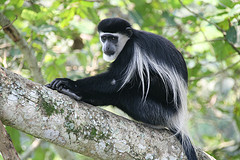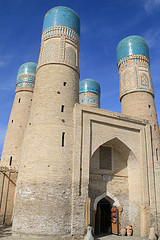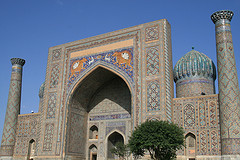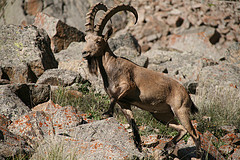Taking it slowly in Uganda
Sunday, August 22nd, 2010We’ve been in Uganda for two weeks now, so I suppose I should offer some impressions of the country. It’s the most laid-back and relaxing country we’ve been to in East Africa, with easily the friendliest people, and these aspects have been most welcome. It’s also by far the most interesting market country we’ve seen in East Africa – it seems every other town or village has a twice-weekly market, and everywhere you go throughout the country you can see large bunches of unripe, green bananas being sold or, most often, being strapped onto a bicycle. (These are mashed up to form matoke, the most popular food staple in Uganda).
Unfortunately, given that we’ve already seen gorillas in the DRC and the savannah animals in Kenya, Uganda does lack a bit of star power in terms of attractions. Indeed, we thought about speeding through Uganda and returning to Kenya six or eight days before our flight out to climb Mt. Kenya or visit Lake Turkana. But instead we decided to take it easy and meander slowly through Uganda, stopping for a day or two longer here and there.
 The highlights so far have been two relaxing camping spots: Lake Bunyonyi in the southwest and the Crater Lakes near Fort Portal in the west. At Lake Bunyonyi, we stayed at a fantastic place on one of the islands called Byoona Amagara, where for three days we forgot about Africa and instead read books, watched movies, ate great food and met some interesting fellow travellers. Unfortunately it is quite dry and brown at Bunyonyi at this time of year, but it was still a very pleasant stay nevertheless. Further north at Lake Nkuruba, we spent three nights camping on the rim of a volcanic crater lake with vervet, red colobus and black-and-white colobus monkeys for company. The black-and-white colobus monkey is perhaps the most handsome monkey we’ve ever seen with its white face, black fur, white fringes and black tail with a white tip, and it was fantastic to see them up close at our own leisure around the campsite (especially since we nearly paid $140 to track them in Rwanda!).
The highlights so far have been two relaxing camping spots: Lake Bunyonyi in the southwest and the Crater Lakes near Fort Portal in the west. At Lake Bunyonyi, we stayed at a fantastic place on one of the islands called Byoona Amagara, where for three days we forgot about Africa and instead read books, watched movies, ate great food and met some interesting fellow travellers. Unfortunately it is quite dry and brown at Bunyonyi at this time of year, but it was still a very pleasant stay nevertheless. Further north at Lake Nkuruba, we spent three nights camping on the rim of a volcanic crater lake with vervet, red colobus and black-and-white colobus monkeys for company. The black-and-white colobus monkey is perhaps the most handsome monkey we’ve ever seen with its white face, black fur, white fringes and black tail with a white tip, and it was fantastic to see them up close at our own leisure around the campsite (especially since we nearly paid $140 to track them in Rwanda!).
The camp sites aside, other things we’ve done in Uganda include tracking the very rare golden monkey as well as chimpanzees, though in both cases we only saw the primates high in the tree canopies, and visiting a Batwa (pygmy) village in the southwest, which was interesting enough.
We have now arrived in the capital Kampala, where we have some admin-type things to take care of over the next couple of days. Those tasks aside, we’ve pretty much done everything we wanted to do in East Africa, so we’ll head to Sipi Falls in the eastern part of the country for our last relax/camp stop in Uganda, and then take the bus back to Nairobi.



